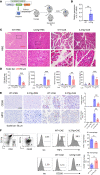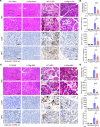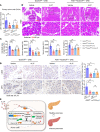Interleukin-37 protects against acinar cell pyroptosis in acute pancreatitis
- PMID: 36166295
- PMCID: PMC9675483
- DOI: 10.1172/jci.insight.161244
Interleukin-37 protects against acinar cell pyroptosis in acute pancreatitis
Abstract
Acute pancreatitis (AP) is a local and/or systemic inflammatory disease that starts with acinar cell injury and necrosis; it has no effective medical treatment and thus remains a life-threatening condition. Interleukin-37 (IL-37), a natural immunomodulator, has demonstrated an antiinflammatory effect; however, the role of IL-37 in AP remains unknown. The serum IL-37 levels of 39 healthy controls and 94 patients with AP were measured. Cholecystokinin was applied to induce pancreatic acinar cell injury in vitro. Classical experimental AP models, such as caerulein, l-arginine, and taurolithocholic acid 3-sulfate disodium salt, were included in the in vivo study. A transgenic mouse model with the IL-37 gene and administration of recombinant IL-37 were used to further investigate the function of IL-37 in AP. Pancreas-specific gasdermin D-knockout (GSDMD-knockout) mice were used to explore the protective mechanism of IL-37. Our results showed that serum IL-37 levels in humans were negatively correlated with the severity of AP. Furthermore, IL-37-transgenic mice and supplementation with recombinant IL-37 could both protect against AP. Mechanistically, IL-37 was able to suppress pyroptosis of injured acinar cells, and specific depletion of GSDMD in the pancreas counteracted the protective effect of IL-37. Our study demonstrates that IL-37 protects against acinar cell pyroptosis in AP.
Keywords: Cytokines; Gastroenterology; Inflammation; Pharmacology.
Figures






Similar articles
-
Chaiqin chengqi decoction alleviates acute pancreatitis by targeting gasdermin D-mediated pyroptosis.J Ethnopharmacol. 2024 Jan 10;318(Pt A):116920. doi: 10.1016/j.jep.2023.116920. Epub 2023 Jul 21. J Ethnopharmacol. 2024. PMID: 37480969
-
Acinar cell NLRP3 inflammasome and gasdermin D (GSDMD) activation mediates pyroptosis and systemic inflammation in acute pancreatitis.Br J Pharmacol. 2021 Sep;178(17):3533-3552. doi: 10.1111/bph.15499. Epub 2021 May 21. Br J Pharmacol. 2021. PMID: 33871879
-
HDL inhibits pancreatic acinar cell NLRP3 inflammasome activation and protect against acinar cell pyroptosis in acute pancreatitis.Int Immunopharmacol. 2023 Dec;125(Pt A):110950. doi: 10.1016/j.intimp.2023.110950. Epub 2023 Oct 25. Int Immunopharmacol. 2023. PMID: 37890377
-
Mechanisms of interleukin-22's beneficial effects in acute pancreatitis.World J Gastrointest Pathophysiol. 2016 Feb 15;7(1):108-16. doi: 10.4291/wjgp.v7.i1.108. World J Gastrointest Pathophysiol. 2016. PMID: 26909233 Free PMC article. Review.
-
Pyroptosis in acute pancreatitis and its therapeutic regulation.Apoptosis. 2022 Aug;27(7-8):465-481. doi: 10.1007/s10495-022-01729-w. Epub 2022 Jun 10. Apoptosis. 2022. PMID: 35687256 Review.
Cited by
-
Bile acid metabolomics identifies chenodeoxycholic acid as a therapeutic agent for pancreatic necrosis.Cell Rep Med. 2023 Dec 19;4(12):101304. doi: 10.1016/j.xcrm.2023.101304. Epub 2023 Nov 29. Cell Rep Med. 2023. PMID: 38035885 Free PMC article.
-
Global insights and knowledge mapping of immunity and inflammation in acute pancreatitis: A bibliometric and visual analysis.Medicine (Baltimore). 2025 Jun 13;104(24):e42898. doi: 10.1097/MD.0000000000042898. Medicine (Baltimore). 2025. PMID: 40527784 Free PMC article.
-
CPT1A mediated preservation of mitochondrial inhibits pyroptosis in pancreatic acinar cells.Front Cell Dev Biol. 2025 Jul 11;13:1577669. doi: 10.3389/fcell.2025.1577669. eCollection 2025. Front Cell Dev Biol. 2025. PMID: 40718711 Free PMC article.
-
Interleukin-37 modulates microglial phenotype and inhibits inflammatory response via the MyD88/NF-κB pathway in lipopolysaccharide-induced neuroinflammation.Inflamm Res. 2025 May 29;74(1):87. doi: 10.1007/s00011-025-02048-x. Inflamm Res. 2025. PMID: 40439750
-
Emodin-Enhanced hUC-MSC extracellular vesicles alleviate acute pancreatitis by targeting inflammation and pyroptosis.Stem Cell Res Ther. 2025 Aug 6;16(1):434. doi: 10.1186/s13287-025-04496-y. Stem Cell Res Ther. 2025. PMID: 40770818 Free PMC article.
References
-
- NCD Risk Factor Collaboration (NCD-RisC) Worldwide trends in body-mass index, underweight, overweight, and obesity from 1975 to 2016: a pooled analysis of 2416 population-based measurement studies in 128·9 million children, adolescents, and adults. Lancet. 2017;390(10113):2627–2642. doi: 10.1016/S0140-6736(17)32129-3. - DOI - PMC - PubMed
Publication types
MeSH terms
Substances
LinkOut - more resources
Full Text Sources
Medical
Molecular Biology Databases

